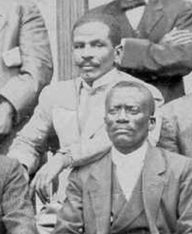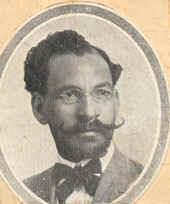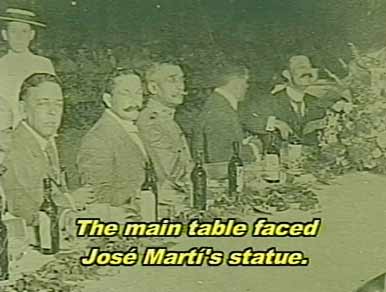

 |
AfroCubaWeb
|
 |
El Doce - 1912
|
 |
|
Evaristo Estenoz |
In Guantanamo, the mayor, Pedro Augustin Perez, ordered the massacre of 50 AfroCubans, mostly Haitians, in one night and sanctioned many other murders. Perez came from a family of rancheadors (bounty hunters) tasked with tracking escaped slaves - his uncle Miguel Perez was killed by Guillermo Moncada on a special mission from Máximo Gómez.
 |
|
Pedro Ivonet, a founder |
AfroCuban culture and religion as well as political aspirations were all severely repressed across the island. Precisely Marti's son, José Francisco Martí y Zayas-Bazán, who had been a captain in the Mambi Army, was chief of staff of the Cuban Army as it carried out this massacre. After the white supremacist victory, the government and big business held a celebratory banquet in Central Park, Havana, which was presided over by Marti's son under the statue of his father and attended by many of the troops involved.
The event was rarely spoken of again until Serafin Portuondo Linares wrote about it in 1950. A communist, he was criticized by his party for not following a stricter class analysis, yet his was the first book written based on primary sources. Interest then waned.
Aline Helg's book Our Rightful Share (1995) and Gloria Rolando's film Roots of my heart (2001) really opened up the discussion in recent years. Without Aline Helg's book, it is doubtful that the Cubans would have rescued this forgotten and repressed story in time for the 2012 centenary commemoration. In particular, she documented the celebration that took place in Havana right under the statue of Jose Marti with José Francisco Martí at the head of the table being honored for his genocidal work -- an image reminiscent of the lynching picnics in the USA, except that this was done with the participation of the son of the Cuban George Washington.
This theme has until recent years been largely ignored by both sides of the Florida
Straights, but it is increasingly being researched by numerous scholars in and outside of Cuba.![]()
 |
|
Celebrating the
massacre in Havana's Parque |
How many people were murdered?
1/07
According to Aline Helg (Our Rightful Share,
p225), the Cuban
Government at the time put the figure at 2,000 while American citizens in
Oriente put it at 5,000 to 6,000 and an Independiente, Guillermo Lara,
spoke of 5,000. According to Maritza
Elias, professor of history in La Maya, Oriente, that town alone saw
3,000 executed.
Tomas Fernández Robaina (2006) did research in the Biblioteca Nacional in Havana, where he is based
with access across the country, and reached a total of 12,000 killed.
Some would still deny the importance or the seriousness of the event, much as today there are those who deny the multiple Holocausts of WWII, the Armenian Genocide, and similar events.
Silvio Castro Fernández, La Masacre De Los Independientes De Color En 1912, Editorial de Ciencias sociales, la Habana, 2002
Rafael Conte, José M. Capmany, Guerra de Razas (Negros contra blancos en Cuba), Imp. Militar de Antonio Perez, Muralla 40, Havana, 1912 [4 PDFs, 4MB total] See also www.gutenberg.org/files/37747/37747-8.txt for searchable text version, no photographs.
Pedro Antonio García: Cuba 1912: La masacre racista, Bohemia, 7/2/07
Gatewood, Willard B., Jr. "Kansas Negroes and the Spanish-American
War." [PDF, 2.5MB]
Kansas Historical Quarterly 37 (Autumn 1971): 300. Focuses on black newspaper reaction but includes photos of 23rd Kansas,
an all
black regiment commanded by black officers, which did garrison duty in
Cuba, 1898-1899. See also Spanish
American War.
Hellwig, David J. "The Afro-American Press and US Involvement in Cuba, 1902-1912." Mid-American 72 (April/July 1990) Also in Between Race and Empire: African-Americans and Cubans Before the Cuban Revolution by Lisa Brock and Digna Castañeda
Jiribilla, febrero, 2002 - 1912 con Fernando Martínez Heredia, Silvio Castro, Aline Helg
Mellen, Jim: Cuban Soldiers in the Spanish-American War, Small Planet
Serafin Portuondo Linares, Los Independientes de Color: Historia del Partido Independientes de Color, La Habana 1950 - 287 p PDF 4.2MB
Sierra, J.A. Race
War of 1912, historyofcuba.com, 2007
Race
War of 1912 - A Timeline
Wikipedia: Amador de Jesús Liens Cabrera (1849-1912) Teniente Coronel del Ejercito Libertador de Cuba, patriota y veterano de las guerras de independencia (la del 68 y la del 95). "Aunque en la región de Bayamo no hubo acción ninguna, fue inevitable que la fobia a dicho grupo de alzados influyera en las mentes de los racistas y crear grupos armados para atacar a los negros y mulatos pacíficos. Amador Liens con sus hijos se opuso a esto pues el decía “que esos negros y mulatos pelearon con él por la independencia”. Al enfrentarse a uno de los cabecillas racistas, su propio yerno Manuel Álvarez (casado con Emilia), este le disparó a Amador Liens"
 |
|
Bust of Martin Morua Delgado |
Up until August, 2008, there were no monuments to the Independents of Color. In 2008, the Comision Organizadora del Centenario put together a plaque to commemorate the founding of the party in 1908.
The silence imposed on 1912 was highly effective.
There is a very large statue of President José Miguel Gomez on Avenida de los Presidentes, la Habana. He was president in 1912 and ordered the massacre. It was torn down in 1959 with the triumph of the Revolution, but was later restored by Eusebio Leal, the Historian of Havana.
In Guantanamo, there is a bust of Martin Morua Delgado, who betrayed his fellow AfroCubans by proposing the Morua Amendment to outlaw the Independents of Color.
Former Minister of Culture Armando Hart has transformed the Havana house of Marti's son, José Francisco Martí y Zayas-Bazán, into the seat of a Centro de Estudios Marti. Francisco Marti headed a group of vigilante volunteers on a murderous rampage against the Independents of Color. During the centenial year of the massacre, 2012, Eusebio Leal Spengler and Armando Hart unveiled a plaque commemorating 1912 Massacre leader José Francisco Martí.
Pedro A. Perez, the mayor of Guantanamo who ordered the liquidation of numerous AfroCubans, has a street and a park named after him in Guantanamo and there is also a statue honoring him. The black community there is aware of his history but party leaders continue to glorify him.
Perhaps the most lasting monument to 1912 is in the Cuban psyche: whenever a group of Blacks gather in Cuba, it is not uncommon to hear an Iberian Cuban say, mostly in a "joking" way, "Ustedes estan formando un partido de negro? Que cosa!" - "You all are forming a party of blacks? What a thing!"
Conmemoracion de la Fundacion del Partido de los Independientes de Color, 7/8/08 de Gloria Rolando Commemoration of the Founding of the Party of the Independents of Color, 8/7/08 by Gloria Rolando
Massacres in the Americas
The 1912 Massacre was far from unique in the annals of the Americas.
The Rosewood Massacre, 1923
Ethnic Cleansing in the Dominican Republic, 1937 and 2015
Tulsa Race Riot of 1921: Coming to terms with America’s terror attack on Black America 11/17/03 Black America Today
Third World - 96 Degrees In The Shade: song about a massacre in Jamaica
96 degrees in the shade
real hot in the shade
said it was 96 degrees in the shade
ten thousand soldiers on parade
taking i and i to meet a big fat boy
sent from overseas
the queen employ
excellency before you i come
with my representation
you know where i'm coming from
you caught me on the loose
fighting to be free
now you show me a noose
on the cotton tree
entertainment for you
martyrdom for me
96 degrees in the shade
real hot in the shade
some may suffer and some may burn
but i know that one day my people will learn
as sure as the sun shines, way up in the sky
today i stand here a victim the truth is I'll never die
96 degrees in the shade
real hot in the shade
![]()

Members of the Party: the Independents of Color
© Gloria Rolando, 2001
1912 Rafael Conte, José M. Capmany, Guerra de Razas (Negros contra blancos en Cuba), Imp. Militar de Antonio Perez, Havana
1950 Serafin Portuondo Linares, Los Independientes de Color: Historia del Partido Independientes de Color, La Habana
1962 Sergio Aguirre, El cincuentenario de un gran crimen, article published in Cuba
1973 Rafael Fermoselle, Politica y color en Cuba: La Guerrita de 1912 (Black Politics in Cuba: The Race War of 1912) , Editorial Colibri, 1st edition 1973, 2nd edition 1998, paperback. The author works for the US State Department.
1974 Joel James Figarola, Cuba 1900-1928: La República dividida contra sí misma. The author was director of Casa del Caribe in Santiago. James, deceased 6/2006, left unpublished a reportedly well written manuscript focused on 1912.
1990 Tomas Fernández Robaina, El Negro en Cuba: Apuntes para la historia de la lucha contra la discriminacion racial: portion on 1912
1995 Aline Helg: Our Rightful Share, 1995.
2001 Gloria Rolando: Roots of My Heart
2002 Silvio Castro Fernández, La Masacre De Los Independientes De Color En 1912, Editorial de Ciencias sociales, la Habana
Numero 42 de Jiribilla, dedicado al PIC
2004 La Maya y la Masacre de 1912: Eugène Godfried En Dialogo Con Maritza Elias,
2007 Eugène Godfried in Dialogue with Ricardo Riquenes Herrera on the Partido Independiente de Color & the 1912 Massacre of Blacks In Guantánamo, Cuba
2007 Pedro Antonio García: Cuba 1912: La masacre racista, Bohemia, 7/2/07
2011 Panel de los Independientes de color, Academia de la Historia de Cuba
See The Independents of Color and the Massacre of 1912 in the media
Not mentioned much in current Cuban or exile political discourse, el Doce surfaces in a speech by Fidel on 8/16/07 whose import is that it legitimizes discussion of 1912.
En 1912 el Secretario de Estado de Cuba, Manuel Sanguily, negoció con la cancillería norteamericana un nuevo tratado por el que Estados Unidos renunciaba a sus derechos sobre Bahía Honda a cambio de una ampliación en los límites de la estación en Guantánamo.
En ese mismo año, cuando se produjo el alzamiento del Partido de los Independientes de Color, que el gobierno del presidente José Miguel Gómez —del Partido Liberal— reprimió brutalmente, salieron de la Base Naval en Guantánamo tropas norteamericanas que ocuparon diferentes poblaciones de la antigua provincia de Oriente, cercanas a las ciudades de Guantánamo y de Santiago de Cuba, con el pretexto de "proteger vidas y haciendas de ciudadanos estadounidenses".
de EL IMPERIO Y LA ISLA INDEPENDIENTE, Granma, 8/16/07
www.granma.cubaweb.cu/secciones/reflexiones/esp-043.html
The context is a list of depradations committed by US troops out of Guantanamo.
Several students in the audience, noting the racist character of U.S. society, asked how Cuba is confronting the legacy of racism today. "Fighting discrimination and marginalization is at the heart of many of the educational campaigns in Cuba, like the training of social workers," the Cuban minister said.
He noted that a growing discussion is taking place in Cuba about Black organizations in the years prior to the revolution and the history of the struggle against racist oppression.
For example, "a massacre of Blacks who had revolted in 1912 was covered up for many years before the revolution, and for many years after the triumph of the revolution it was not discussed much, but some books have recently been published that talk about that history." The uprising was led by a Black party called the Independents of Color.
Pointing to another example, Prieto said, "In their music, Black rap musicians react to the continuing manifestations of racial prejudice in Cuba."
in "U.S. youth discuss defense of revolution with
Cubans"
www.granmai.cubasi.cu/ingles/2003/agosto03/vier29/perpectiva.html
Prieto would be referring to the following books:
Los Independientes de Color: Historia del Partido Independientes de Color Serafin Portuondo Linares La Habana 1950, reprinted in 2002
Aline Helg: Our Rightful Share, 1995. Published in Cuba in 2000 as Lo que nos corresponde: la lucha de los negros y mulatos por la igualdad en Cuba 1886-1912
La Guerrita
del Doce, noventa años después, UNEAC
Gisela Arandia Covarrubia, Granma, 6/17/02
La Masacre de los Independientes de Color, 20/5/07, Granma, Silvio Castro
The Communist Party line has in the past tended to diminish the importance of the role of President Gomez in 1912 and accentuate the role of US troops, who were involved in only one reported shooting incident. Rather they "Cubanized" the action, supporting Cuban troops by taking over the guarding of plantations, rail roads, and other strategic points so the Cubans could prosecute their massacre. As more of the 1912 events have come to light, this emphasis has diminished.
LA GUERRA RACIAL DE 1912
Por Hugo J. Byrne
www.amigospais-guaracabuya.org/oaghb115.php
La matanza de Oriente
Dimas Castellanos, Encuentro, 4/07
"No fue la Enmienda Constitucional, sino la desatención de la agenda de los negros, el empleo de la violencia verbal o física para dirimir sus diferencias y la persistente discriminación racial, los factores que condujeron al mar de sangre de 1912 y que aún están presentes en la sociedad cubana: una enseñanza de vital importancia para nuestra historia presente."
A classic blame-the-victims exposition from Encuentro, a publication run by exiles in Spain with funds from NED. In the words of one researcher, "this is the most employed lame excuse that the ibero-spanish elite uses to rationalize the criminal acts of their class represented by Jose Miguel Gomez."
[AfroCubaWeb] [Site Map] [Music] [Arts] [Authors] [News] [Search this site]